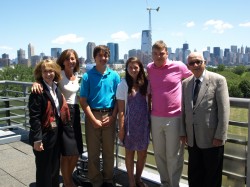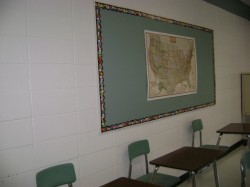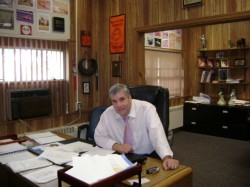Sept. 11 Curriculum Makes its Way to N.J. Schools
by cleiva • September 26, 2011 • News • 0 Comments
By COURTNEY LEIVA, JILLIAN PARKER and MIKE DRURY

(From L-R) Dr. Gaffney, Mary Ellen Salamone and family, and Paul Winkler. (Photo courtesy of Allison E. Kobus)
Although she lost no one that September morning, Donna Gaffney remembers the anxiety she felt when she realized that her son who worked in buildings surrounding the World Trade Center, was missing for four hours.
“I was in Michigan when I heard the news, my son worked in one of the nearby buildings and we could not get in touch with him for four hours. When I heard his voice on the phone, relief overwhelmed me. Our family was very lucky,” Gaffney says.
As the co-founder of the 4 Action Initiative organization, an organization created by families of 9-11 in order to raise awareness of terrorism and public trauma, Gaffney wanted to make a difference and help others.
After the initiatives formation in Oct. 2001, Gaffney was soon named the co-founder of the initiative alongside Mary Ellen Salamone a mother of three who lost her husband in the attacks. Although it took several years to create the curriculum, the goal was to create the curriculum before the 10 year anniversary of the attacks.
“When Mary Ellen approached me, it was clear that this curriculum was a very important project. I then reached out to Dr. Emlyn Koster at Liberty Science Center and the collaboration was born.”
Although Mary Ellen Salamone was mainly in charge of the curriculum project, as co-founder of the initiative, Gaffney used her experiences as a mental health professional to help designate the curriculum. Gaffney wrote three new lessons which will be included in the curriculum at a later date.
“As a mental health professional my responsibility was to make sure that this curriculum did not traumatize students. I am also an author and an educator, and was part of the core group who decided which lessons would be included. I also worked with several others to edit the lessons and consulted with the graphic designer for the overall look of the curriculum book.”
As a mother of three, 4 Action Initiative founder Mary Ellen Salamone wanted to find a way to talk to her children about difficult subjects like terrorism, hate, security issues connected with 9-11. The goal is to not only help students understand 9/11, but to also get them involved.
After teaming up with the Liberty Science Center as well as the New Jersey Department of Education, the curriculum has already seen its way into N.J. school districts. Met with praise and curiosity by many students, many N.J. educators are willing to bring the curriculum into their own districts.
What’s in curriculum?
With the help of volunteer teachers and professionals, the 4 Action Initiative developed the curriculum “Learning From The Challenges Of Our Times: Global Security, Terrorism and 9-11 in the Classroom.”
Released on July 14, 2011 to the Liberty Science Center in New Jersey, schools and teachers, the curriculum guides teachers on how to teach students sensitive subjects like 9-11 in the classroom.
Lesson plans include teaching events that occurred on the day of Sept.11 and examines different topics for different age groups in grades K-12 in more than 60 New Jersey school districts.
Organized in seven themes, the curriculum covers human behavior, aggression and violence in our world, and historical aspects of terrorism. Always keeping lessons age appropriate; teachers layered the curriculum with complex topics that are age-appropriate and easy for students to understand.
For example, “Impact of Hateful Words” is for elementary students, “What is Terrorism?” is taught in middle school, and “Reaction to and from the Muslim and Arab Communities” is for high school students.
Writers of the curriculum have also been very careful what and what not to include as graphic images are strongly avoided.
“We have gone to deliberate lengths for teachers not to use graphic images in the classroom,” Gaffney says.
Although the curriculum has not been brought to all N.J. schools, many educators are very open to bringing lessons like these to their classrooms.
N.J. Educators’ thoughts on the curriculum
Hopatcong high school Principal Emil Binotto calls Sept. 11 the Pearl Harbor of our time and finds that an event like this relevant in the classroom.
“It’s not too soon for the curriculum to come to schools as our foreign policy, military effort, and economy is directly tied to this event. It is also addressed as a causal factor of current and future world events and issues and it can be used as a real life, personal illustration for concepts taught in history classes,” Binotto says.
Jim Marino, a history teacher at Hopatcong high school, has covered Sept. 11 in his classroom every single year since the attacks happened. Like Binotto, he is open to teaching the curriculum, as 9-11 has changed American history forever.
“It is an event which has repercussions at every single level of American society and culture, and will reverberate for the next century too,” Marino says.
Teachers at Valley Middle School, in Oakland, N.J., were no exception. It took social studies teacher John Messina a few years to really figure out how he wanted to teach terrorism.
“With the events surrounding 9/11 you have to be sensitive to the age group. They are taught young that America is a wonderful, terrific country and as they get older they start to realize that there are people out there that don’t like America and this idea of terrorism is out there for the sole purpose of creating fear,” Messina says.
“Generally your typical 6th grader is not ready to grapple it. You have to take a careful approach. This year we didn’t focus in on hatred of certain groups toward America, and the attacks itself, but focused more on the aftermath and how despite the tragic events, instead of it weakening us it strengthened us. It got us to work together and create situations where we put aside our differences,” Messina adds.
While it took Messina some time to decide how he wanted to teach Sept.11 to his students, his colleague Tom McGoldrick sought a more direct approach.
“I do a whole segment on terrorism and make it non-ethical; the history of terrorism and different groups so that way we don’t solely focus on Muslims,” said McGoldrick. “I went to Dr. Lane (the principal at the time) and said I want to discuss terrorism and he suggested a video as long as it’s non denominational.”
McGoldrick also wanted to inform his students about 9/11 and terrorism right away. He wanted to make sure his students were properly educated about what had happened and what would happen.
“I started teaching it the very next year,” continued McGoldrick. “There was so much confusion. If you asked 7th graders where the hijackers came from they would say Afghanistan or they would say Iraq and they assumed that’s where the hijackers came from.”
While McGoldrick took the head-on approach, Messina was still having some trouble finding out how he wanted to talk about terrorism to his students.
“Up until this year they said teach Sept. 11. That’s a problem because what do you do?” asked Messina. “As teachers you don’t work together on it. One might focus on the events and others might focus on something else. Every year it changed. Sometimes I just glossed over it, especially in the early years. Usually you are with your students for less than a week on 9-11 so you don’t know your students well yet. It’s too huge of an issue to tackle. Today it is better. I like the approach where we focus on the heroes and how we united ourselves.”
While both teachers have different ways of approaching this issue, they are both agree that students today are not as well educated on the subject as students who were in their seats 10 years ago.
“The kids don’t have a lot of information. I asked them where they were and most were in preschool so they were only 2-3 years old. They do not have as much as nearly understanding as someone who was their age at that time. They didn’t know it was more than 2 towers. They didn’t know what building seven was,” concluded McGoldrick.
“Today kids were just babies when this was born and they don’t know much at all,” agreed Messina. “They come in knowing very little. Some kids come in with more exposure. It’s up to the families. Seven to ten years ago, those kids lived through it so they could talk about the experiences. Today these kids were too young and don’t recollect the American flags showering down on towns. It’s up to us to really approach Sept.11 in an honorable way and let the next generation understand it.”
Clifford Peterson, Assistant Professor of Political Science, who is currently teaching the course “Terrorism in the Modern World” at Ramapo College, thinks the curriculum is very crucial in the high school classroom.
“A curriculum unit for high school students on terrorism is very important and particularly relevant in the New York metropolitan area. There are major issues that remain unclear or unresolved such as the very definition of terrorism, its causes, and the psychological profiles of terrorists, the effectiveness of counter-terrorism strategies and homeland security and the civil liberties implications. Hopefully, such a curriculum unit will contribute to clarifying these issues and to better public policy in the future,” Peterson says.
Moving Forward
Although terrorism remains a sensitive subject to many, Gaffney at the 4 Action Initiative assures that the curriculum itself is more than just teaching about terrorism and with its debut in many schools, Gaffney says the student response to the curriculum has been overwhelmingly positive.
“Students are very interested in the curriculum as we have received very positive responses to it,” Gaffney adds.
Check out Integritas’ timeline on the development of the 4 Initiatives Curriculum.
As Sept.11 has greatly changed our nation forever, Gaffney hopes that students take something positive from the curriculum.
“This curriculum is not just about or for the singular day of 9/11. It’s a curriculum that is broader and deeper and can be used all year long, and ultimately brings students to the realization that one can take action, volunteer and make a contribution, no matter how young they are,” Gaffney says.
For John Messina at Valley Middle School, students should also focus on the positive as they should reflect on the themes of strength and unification when learning about Sept. 11.
“That’s the stuff we have to remember about 9/11, and how it strengthened and unified us.”
To see the complete curriculum: http://www.state.nj.us/education/holocaust/911/k12curr.pdf
VIDEO: Check out 4 Action Initiative Video



